| THE MG |
|
|
 |  |  | December 10, 2008 - Turning my attention from the front of the car to the rear, this showed up today.
It's the rear axle from a 2000 Chevy S10 Blazer 4WD. The width is 59", 4" wider than the 2WD rear and a nice match to my front track. I've pulled the brakes to replace them with Miata parts, which is going to involve a bit of bracketry. Still, nothing too exotic. There's also going to be a lot of cutting of old suspension brackets and welding of new, of course.
I wasn't sure if this was going to be a limited slip or not. Experimentation would indicate not, and changing to the Camaro rear will mean setting up the pinion again. Oh well, it's another skill to learn.
entry 105 - tags: suspension, rear axle |  |  | 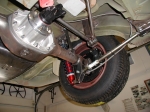 | December 10, 2008 - So, how do I locate the rear axle?
Hanging it off leaf springs just isn't an option for ride, handling and tuning ability. So I'll change over to coilovers and a multi-link setup. Lots of learning here, I've never had to deal with a big stick axle before.
This is a three-link setup as sold by Fast Cars, an MG conversion specialty shop. It would be easier to design and build than a four-link, especially with these photos. However, I'm not too excited about the concept of a panhard rod and the slight lateral movement of the axle it creates - and I'm really not a fan of that bent rod in the Fast Cars kit. This car won't spent a lot of time on the track, but you know it will happen!
More photos of this particular car can be found on BritishV8.org - it's a very thorough conversion and you get a really good look at the suspension design and brackets.
entry 106 - tags: suspension, design, 3-link, rear axle |  |  | 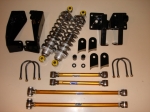 | December 10, 2008 - The other option for the rear is a four-link setup.
It's a little more elegant from an engineering standpoint - the axle is nicely constrained. But it's more of a challenge to design well, as there's potential for binding. I have to admit I'm not completely sure how to design that, or if it's really a risk. I've been running the kinematics of both designs in my head all day, trying to figure it all out.
The picture is of a commercially available kit from Classic Conversions, and it's actually designed to bolt into the chassis. Pretty nice. According to a writeup (with more pictures) on BritishV8.org, it's designed to have a bit of roll oversteer which is something I'd prefer to avoid. Still, it's a good option - although with a price of over $1000, it's more likely that I'll use it as a proof-of-concept.
entry 107 - tags: suspension, rear axle, 4-link |  |  | December 15, 2008 - Not much actual work on the car, but lots of planning.
I'm going to go with a three-link rear after talking with a number of road racers and other folks on the Grassroots Motorsports forum. The lateral motion of a long Panhard bar isn't a big deal at all it seems, and it's free of bind and easy to fabricate. So there's that settled. I just have to do it!
I'm also starting to plan the brake system. Very little of it will be MG by the time I'm done. In fact, it's possible it will all be custom. I'll have to wait until the motor position is determined before I can finalize this but it's fun to build it in my mind. Brakes are important to me, and I like putting together good systems.
This is actually a very entertaining part of the build. I have all of the major components so I can start legitimately planning and figuring out how to do things. On top of that is the anticipation of the first big steps coming up - I'm looking forward to that first chop of the frame rail with anticipation and a little frisson of nerves. This is the stage where the whole car comes together in concept, making it a complete machine instead of just a collection of bits that are a reaction to unforseen problems.
I love this part.
entry 108 - tags: suspension, brakes, rear axle |  |  |  | December 31, 2008 - It's been a long break over the holidays, but I wasn't able to get much accomplished due to visitors.
Still, I snuck away for a few moments here and there. At the moment, I'm still trying to figure exactly the best way to mount the suspension. First I need to make sure I have the centerline of the car marked. Here, I'm taking the center of the stock crossmember mounting points. I dropped a plumb line down from that X and marked it on the floor. After doing that with a few more locations, I'll have a good record and will be able to chop out the original frame rails.
entry 109 - tags: suspension |  |  |  | December 31, 2008 - Here's a side view of a stock Miata subframe.
I've spent some time measuring it and poking around under the car, trying to figure the best way to mount it. The original plan was to build new frame arms - that's what the other Miata-suspended GT got, although that setup never got beyond the very first stages.
But really, I don't need to mount it. I just need to mount the control arms and steering rack. Hmm.
entry 110 - tags: suspension |  |  |  | December 31, 2008 - As much as I hate the thought of a ladder frame, it might work out.
The original frame rails are at almost the perfect width to let me mount the control arms directly to them. Add an extension at the front to hold the upper control arms and a cross-piece for the steering rack - and voila. The upper arms don't see as many side forces as the lower ones do, but they do see forward forces under braking. The whole thing will probably be more prone to twisting as it's only in one plane, and I'm still concerned about a good upper mount for the shocks. So maybe it does make most sense to continue with the previous design. But it's an interesting possibility.
This tubular subframe actually makes it look like a pretty good option. I'd basically do the same thing, except it would be welded to the frame of the car instead of bolted.
entry 111 - tags: suspension |  |  |  | December 31, 2008 - On a different note, here's a peek at the difference between a Corvette throttle body and a stripped-out Camaro one.
The Corvette (top) uses drive-by-wire and is significantly larger.
entry 112 - tags: engine |  |  |  | January 1, 2009 - Before I start cutting and welding the car, we need to make it a bit more flammable.
Janel wandered into the garage and helped me pull the dashboard. We had a lot of fun trying to decipher the workshop manual instructions. Here, she's trying to find the invisible bolts holding it together.
entry 113 - tags: interior, janel |  |  |  | January 1, 2009 - The dash is almost out.
I just need to label the wiring and we can disconnect it. Due to the poor paint job on the dash, we're going to make it black again. The whole interior of the car was painted tan - and with a fairly good job. But at least one of the panels seems to be stock, so hopefully there's a stock equivalent. The door panels are rather wavy.
The dash is going back to black, as the paint job on it is poor. It also needs some repair as can be seen. The choices are to try to patch it up and then respray the dash, buy a $50 top bit to cover it up, or install a $300 dash. We'll see what wins - I'll probably start with option A and see how that turns out.
entry 114 - tags: interior, dash |  |  |  | January 1, 2009 - Whenever disassembling a car to this extent, always bag and label parts.
Who knows how long it will be before it gets reassembled?
The number of fasteners involved in the glovebox was amazing.
entry 115 - tags: interior, tips |  |  |  | January 1, 2009 - The dash is out and disassembled.
Not all of these gauges will get reused, and the mechanical speedometer is liable to be quite problematic with the T56. I love the look of the vintage Smiths gauges, and I'm tempted to open up the speedo and stuff the electronic guts from the Camaro inside. That's a future project though.
entry 116 - tags: instruments |  |  |  | January 1, 2009 - It was fun figuring out how to disassemble the dash.
To remove a few of the knobs, you have to push down a little spring-loaded button. Pretty clever, actually. At least, once you've figured it out. Until that point, it's maddening.
I managed to get everything apart with no breakage.
entry 117 |  |  |  | January 1, 2009 - This octopus was under the dash.
It's the evaporator/distribution box for the air conditioning. I'm tempted to keep it and add AC into the car later, although it'll add a fair bit of expense and make keeping the engine cool a little more difficult. So it's on the shelf for now.
entry 118 - tags: HVAC |  |  |  | January 1, 2009 - Naked MG!
Janel and I attacked the car this afternoon and stripped it right down. Now that this is done, it's time to start the real modification. We did discover that while many of the panels in the car were painted, the seat upholstery was not. So it looks as if we do have a color match to an MG color. Based on the catalogs, I'm guessing "honey tan". We'll probably duplicate a couple of the panels if we can find some vinyl, as a few are a bit banged up.
The size of the fasteners holding the seats down was a little spooky - they're about 1/3 the size of the ones used in a Miata.
entry 119 - tags: interior |  |  |  | January 1, 2009 - Now, the big question.
How's the rust? Despite the appearance in this picture, it's actually looking really good. You're looking at some of the carpet underpad stuck to the floor, for one thing.
There was some surface crust on the transmission tunnel on the passenger's side - displayed here - that I suspect was related to the AC. But all that metal will likely be replaced anyhow, and it showed no signs of weakness under a screwdriver attack.
The side sills also look solid under the vinyl cover on first inspection. I'll hit them with a Scotchbrite wheel and make sure. The floorboards have an asphalt matting on them from the factory that could hide any sins, but it's not showing any sort of cracking or distress that I associate with the eruption of rust underneath. A good inspection from under the car confirms this.
I think this car is as solid as it appears.
entry 120 - tags: rust |  |  | January 1, 2009 - I drove the Camaro just a bit over the holidays.
I also managed to get it stranded at work during a good snowstorm. Dunlop D60 A2s aren't great snow tires. But it's been useful.
First off, I can't wait to liberate this engine from the Camaro. Let's just say that I'm not enamored with the chassis.
Secondly, it's allowed me to identify a couple of little problems. The shifter needs adjusting, I know that. But there was a check engine light on. A bit of monitoring with an OBD-II scanner tells me that the coolant temperature sensor is reading a constant -58F, which I'm pretty sure is not accurate. I suspect that's a "no signal" reading. I'll probably deal with that when the engine is out of the car.
entry 121 - tags: camaro |  |  | 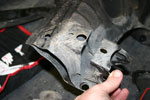 | January 3, 2009 - Now that I've figured out how I'm going to deal with the front suspension, it's time to get cracking.
Lots of measuring and calculating and general head-scratching, and it culminated in this. The donation of control arm brackets (with alignment capabilities) by a stock Miata subframe. The sawzall got a real workout today. That's foreshadowing!
entry 122 - tags: suspension |  |  | 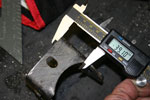 | January 3, 2009 - I've decided the best way to run the rails is just inboard of the stock ones.
That'll let me run them back to the middle of the car (where the stock ones stop) and tie them in together. More strength for the car!
This puts the outside edges of the rails 570 mm apart. To put the brackets in the correct place, they need to be 38.5mm at this dimension. Not bad for cutting with a relatively blunt instrument, no? I'll clean them up a bit on a belt sander before welding. The dimension isn't critical to the half millimeter (0.020" for those who speak the old language) because there's a significant amount of adjustment room in the control arms - but it's good to be fairly accurate here if possible. I'd hate to run out of adjustment for the alignment.
entry 123 - tags: suspension |  |  | 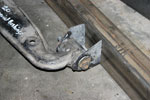 | January 3, 2009 - A view of the bracket on the new frame rail.
The new rails are 2x3" 18 gauge, which is significantly bigger than the stock stuff. Fair enough, there's a lot more running through them! I'll have lateral bracing wherever I can fit it, as well as a bit of vertical to stiffen things up.
After much measuring and poking around and measuring, it turns out that the correct height for the control arms is serendipitously right in the middle of the frame rail. I played around with heights ranging up and down a couple of inches, and this puts them 7" from ground level. That's 1" higher than the ones on Janel's slightly lowered Miata, making the geometry just about a perfect match for a stock Miata.
entry 124 - tags: suspension, ride height |  |  |
|

 THE DIARY
THE DIARY